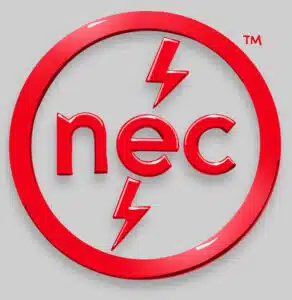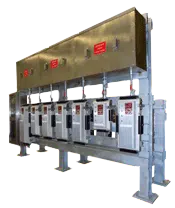 The National Electrical Code (NEC) was created for the protection and safeguarding of industrial personnel and property from potential dangers associated with electrical installations.
The National Electrical Code (NEC) was created for the protection and safeguarding of industrial personnel and property from potential dangers associated with electrical installations.
The NEC is the most superior and the preeminent electrical code in the country. Its primary goal is to establish the foundation and the basis for electrical safety wherever required. When adopted as law in the local jurisdictions, this code becomes even more important.
Why is ensuring compliance with the code important? Because compliance with the NEC makes sure that all power installations are secure and free from potential hazards.
NEC is sponsored and maintained by the National Fire Protection Association (NFPA). Based on the inputs from the public, a committee — with several panels and a technical correlating committee — crafts the regulations and standards of the code.
The NEC is recognized and approved by the American National Standards Institute (ANSI).
The NEC is revised and published tri-annually, based on constant changes and modifications in electrical technology. When a new change or update is made to the code, a majority of states do not immediately adopt and implement them. It takes a few months to a few years for the enforcement of the latest NEC edition. Additionally, states add, omit, or modify specific sections of the NEC as per their requirements.
NEC was first published in 1897, and since then, no court in any state in the country has faulted parties for complying with the latest edition. While it is true that updates are made, the NEC is also unique, considering the fact it is the least amended model code.
Any electrical service provider can access the NEC in various formats — book and digital.
A Brief History of the NEC
The NEC was first introduced in 1897 by various stakeholders in the insurance, electrical, and construction sectors. The original version of electrical safety rules was compiled as a part of The National Conference on Standard Electrical Rules. Representatives from various national associations attended the conference.
Following are some of the key aspects that were covered in the first edition of the NEC:
- Use of single disconnect devices
- Uses of an insulated conduit
- Identification of the white wire
Scope of the National Electrical Code
The NEC is meant for a wide variety of electrical installations in residential, commercial, and industrial environments. Following are the technical applications that are covered by the NEC:
- Installing electrical conductors, raceways, and equipment
- Installation of optical fiber cables and raceways
- Signaling and communications raceways, equipment, and conductors
Adoption of the NEC in Electrical Installations
Cities and states adopt and implement a single set of electrical standards to protect the lives of residents or employees from potential electrical dangers and also to avoid lawsuits.
Hence, electricians from all over the country take part in intensive training that meets the NEC standards to start working as licensed professionals.
The majority of states and their respective jurisdictions adopt and enforce the NEC through a process that makes the code a law. Failure to comply with the NEC is illegal. Amendments can be made based on how that respective jurisdiction interprets a certain rule. Most states and cities go by the suggestions and recommendations of NFPA’s panels which has significantly qualified technical committee members.
The Structure of the NEC
The NEC code consists of an introduction, index, annexes, and nine chapters. It touches on a wide array of aspects concerning electrical safety and regulations, like enforcement, rules, scope, and purpose. Apart from the mainstream information, the NEC Handbook also has multiple cross-references, supplementary illustrations, and explanations to help professionals understand the code better.
The National Electrical Code addresses the requirements concerning branch circuits- specifically the involvement of fixtures and receptacles. The NEC specifies the required minimum number of branch circuits in a location and the amount of spacing distance needed between receptacles in electrical applications. Based on the type of application, the purpose, and also the location, the requirements differ.
Importance of Enforcing the NEC to Ensure Safety at Workplaces
Electrical hazards can cause grave physical danger and also loss of life. Workplace environments that DO NOT comply with the NEC standards are places of risk and danger- to both the equipment and also to the personnel.
It might surprise you, but a lot of workers are ignorant of these potential hazards. In some cases, hazardous electrical installation is re-examined and rectified only after a major accident happens. Arc blasts, shocks, and arc flashes pose a grave danger to the lives of people in a certain facility and also around it.
What is the key to ensuring maximum safety? Consistent education, awareness, and ensured compliance are the keys to safety. Production metrics and financial aspects shouldn’t be used as justifications for non-compliance.
In multiple jurisdictions, failed compliance with NEC rules is a violation of federal law. The responsible organizations can face criminal indictments or large fines. Electrical safety programs are the keys to ensuring employee protection, and all levels of personnel must be included.
What is the NFPA 70 and How Does It Ensure Workplace Safety?
The NFPA 70E 2015, Standard for Electrical Safety in the Workplace, consists of all the requirements that are essential for an effective electrical safety program. They are:
- Identifying electrical safety principles (i.e. safety by design)
- Identifying and adopting safety procedures
- Awareness of electrical hazards
- Using safety tools and personal protective equipment
- Implementing risk or hazard evaluation procedures
NFPA 70E includes specific criteria under which electrical professionals must be trained. Following are a few key points:
- They must be trained and well-versed in the construction and operation of electrical equipment or a specific installation method.
- They should be trained to effectively identify the potential dangers associated with that specific piece of electrical equipment or work method.
- They should be trained to avoid such potential dangers.
- They must be trained in particular precautionary techniques and the usage of special tools such as insulated tools and test instruments.
- They should have considerable knowledge of any policies and procedures.
Spike Electric and NEC Compliance
Spike Electric provides electrical equipment that perfectly complies with the regulations and standards of the NEC. Our experts are well-versed in NEC guidelines, and we ensure that all our products and services follow the respective rules and laws of the jurisdiction. For more information on our products and services, feel free to contact us or browse through our website.
Written by: Cole Attaway
Cole Attaway is the founder and CEO of Spike Electric Controls. Spike's mission is to improve the accessibility and delivery of industrial electrical gear for clients nationwide. Spike solutions result in reduced unplanned downtime, less overtime, and greater operational efficiencies.


